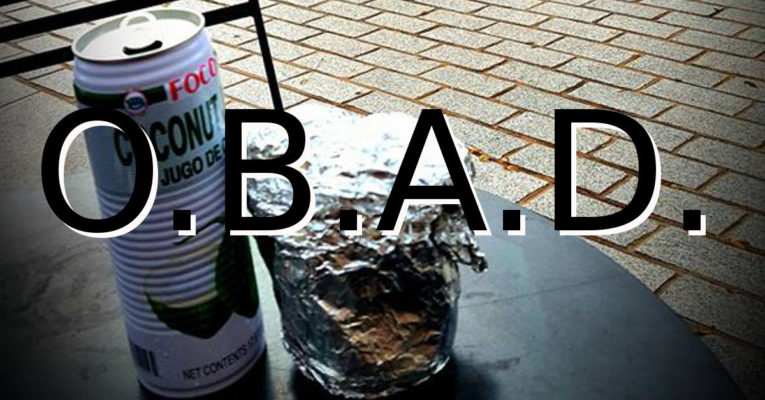One-Meal-a-Day (OMAD) with a Preference for IF and OBAD
| filed under: RNNR, IF Diet, OMAD, OBAD, Intermittent Fasting, O.B.A.D., One Meal a Day Diet Log, One Meal a Day Diet, One Meal a Day, Intermittent Fasting Diet, One Burrito a Day Diet, O.M.A.D., OMAD Diet, IFThings are going better with the diet. I refuse to keep any food in the house. I am even tempted to dump my stone-ground grits and my stone-ground oats—including yummy, yummy, bars of butter.
If I want to eat a meal, I must walk to it—and that does not include Sean's convenience store right downstairs (I hope he doesn't go out of business because of me—at least he's got the slot machines now).
So, I need to at least schlep to Burrito Bros for my favorite Chicken Burrito with Everything on It (around 1,200-1,400 calories) or the mile walk to get a chipotle everything steak burrito (1,385, according to Chipotle's nutrition calc); or, on lovely nights, the two miles to enjoy a nice cardboard container of sundry treats from Whole Foods prepared foods.
But, my limit is 1,500-1,800 calories-per-day in one lump sum, taken in a half-and-hour or within a 4-hour window, if that's the sort of day I am having. I am tracking rigorously using both Vora—to track my intermittent fasting (IF)—and the best investment UnderArmour ever made, MyFitnessPal. I have three rules when I am doing an OMAD diet:
- try to make sure all the macros and nutrients work out (I try to avoid keto or low-carb diets while on this diet)
- make sure I fill up on supplements and vitamins orally in the AM
- drink lots and lots of water (and only black tea or black coffee)
- drink even more water than that—it'll help both the hunger and any stomach acid or reflux issues you may have while your body's getting used to it
- give yourself a break because we all—and especially me—make so many mistakes all the time
- don't believe anyone who says that you can eat whatever you want during an OMAD—one meal-a-day—diet—it's essential, in any diet, to make sure you maintain a deficit between the amount of food you put in and the number of calories you expend (please see my other post, My personal keto diet mistake: overeating my calorie deficit).
Good luck. I'll try my hardest to be as honest with you as I can be. I made a lot of mistakes. Maybe I will start recording and reporting my weight. I really had wanted to but I was just sabotaging myself and was just never getting anywhere. I just thought I would, at some point, take my own advice!
FAQ:
-
What is the OMAD diet?
- OMAD stands for "One Meal A Day." It involves consuming all of your daily caloric intake in just one meal and fasting for the rest of the day.
-
How is OMAD different from Intermittent Fasting (IF)?
- While OMAD is a form of Intermittent Fasting (IF), IF can involve various eating patterns, including the 16:8 method (eating during an 8-hour window) or the 5:2 method (eating normally for 5 days and fasting for 2). OMAD is more specific, focusing on a 23-hour fast with a 1-hour eating window.
-
What does OBAD stand for?
- OBAD refers to "One Burrito A Day", a variant of the OMAD diet where the one meal is a burrito.
-
Do I need to calorie count on OMAD?
- While OMAD provides flexibility in food choices, it's essential to ensure you're maintaining a calorie deficit to achieve weight loss. Trackers like MyFitnessPal can help.
-
Are there any restrictions on what to eat during the OMAD?
- No strict restrictions, but it's crucial to ensure a well-balanced meal that includes essential nutrients.
Glossary:
- OMAD: One Meal A Day, a diet where you consume all your calories in one meal.
- OBAD: One Burrito A Day, an OMAD variant focusing on burritos.
- Intermittent Fasting (IF): An eating pattern where you alternate between eating and fasting.
- Macros: Short for macronutrients, namely carbohydrates, proteins, and fats.
- Vora: An app for tracking intermittent fasting periods.
- MyFitnessPal: A calorie-counting and diet tracking app.
Health Information:
The OMAD diet can offer various benefits, such as weight loss, improved metabolism, and better blood sugar control. However, it can also pose challenges:
- Nutrient Deficiency: Consuming all your nutrients in one meal can be challenging. It's crucial to ensure a well-balanced meal.
- Overeating: The urge to eat a large meal after fasting can sometimes lead to overconsumption.
- Energy Slumps: Some people might experience energy slumps or mood swings due to extended periods without food.
- Digestive Issues: Consuming a large meal in a short window might lead to digestive discomfort for some.
Always consult a healthcare professional before starting any new diet to ensure it's suitable for your individual needs.
Final Thoughts:
Embarking on the OMAD or OBAD journey requires discipline, patience, and awareness. While the flexibility of eating what you like in one meal might sound appealing, it's crucial to prioritize nutrient-rich foods to maintain overall health. Track your progress, listen to your body, and make necessary adjustments as you go along. And remember, it's okay to make mistakes; consistency is the key.


